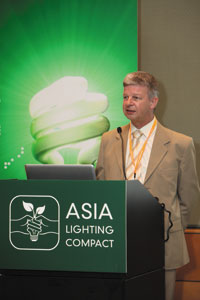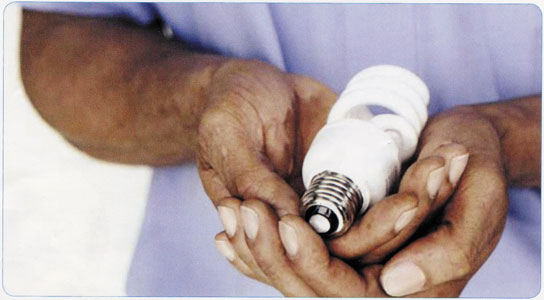ALC Launched at HK Lighting Fair to Expose Shady Side of CFL Lighting
One of every two CFLs sold in
2010/01/13 | By Ken LiuOver 50 representatives from various government agencies, lighting manufacturers, lighting associations and quality inspection institutes launched an NGO called Asia Lighting Compact (ALC) on the sideline of the Hong Kong International Lighting Fair 2009 (Autumn edition), held from Oct. 27-30, to address a rampant, insidious but unsurprising issue regarding CFLs or compact fluorescent lamps-that one of every two CFLs sold in Asia are substandard, in fact producing less light or burning out faster than advertised or required by national regulation.

The ALC says that a CFL typically uses 75% lesser energy than an incandescent lamp to give off the same amount of light, with some 11W spiral models being as bright as a 65W incandescent bulb. With the whole point of making CFLs to reduce CO2 and power consumption, substandard CFLs are not living up to the task, and worse deceiving consumers with false advertising. "Making sure to turn out quality, regulation CFLs will help to reduce regional energy consumption and Asia's overall CO2 emission by at least 2.4 million metric tons a year. This is equal to planting nearly 300,000 hectares of trees or removing nearly 450,000 cars from roads. The energy saved can light 2.8 million homes for a year," according to the ALC press release.

An analysis by the federal-level United States Agency for International Development (USAID) indicates that 85% of the poor-quality CFLs sold in Asia could be replaced with regulation types within four years, to reduce at least 10 million metric tons of CO2 emissions within eight years.
CFLs to Replace Incandescent Bulbs
Increasing promotion of the merits of CFLs in recent years, says the ALC news release, has significantly accelerated global demand for such lamps, helping also to boost global production to three billion CFLs in 2008 from 2000's 500 million. The ALC expects such output to further increase to as many as 10 billion CFLs per year due to gradual phasing out of incandescent bulbs.
"Ninety percent of CFLs are produced in China," said Marten F.C. Willemsen, Director of marketing, Global Business Unit CFLi, Phillips (China) Investment Co., Ltd., Phillips Innovation Campus Shanghai when interviewed by CENS Lighting Magazine. Philips is among the ALC's founding members along with GE Lighting and Industrial, Lighting Council Australia, Philippine Lighting Industry Association, ELI Quality Certification Institute, Havells Sylvania, Danson Electronics (HK) Ltd. Danson Electronics Pty Ltd, Zhejiang Yankon Group Co., Ltd., International CFL Harmonization Initiative (CFLI), Pure Spectrum, and the Sustainable Energy Association of Singapore (SEAS), the Australian Government Department of the Environment, Water, Heritage and the Arts, and the USAID ECO-Asia Clean Development and Climate Program.
Willemsen summed up the essential cause of sub-standard CFLs: a lack of universal standards for such lighting and consumer ignorance about CFL quality. Echoing the difficulty behind realizing any grand mission, Willemsen said it is also tough to coordinate different people from various groups to set up and agree on common standards. One nation is generally uninterested in cooperating with another. Without detailing the politics of such scenario, Willemsen did not say that conflict-of-interest may be a key factor, that a nation with advanced CFL makers would hesitate to work with emerging makers in developing nations, helping them turn out standard CFLs with technology and equipment transfers, where realities of business often prevail over eco-conscientiousness or even morality. The director confirmed that a long time is required to convince a nation that teamwork is far superior to individual efforts toward ecological causes. Many countries have been earnestly trying to standardize CFL specifications on their own, without taking time to make such standards globally-accepted.
Defrauding Consumers
Further confirming the deceptive advertising issue, Willemsen said that consumers are being literally defrauded, for CFLs are promoted as replacement for incandescent bulbs, but many do not perform as claimed and yet cost more than incandescent lamps.
"This initiative comes at exactly the right time, when governments worldwide try to find ways to address climate change and Asian countries in particular are concerned about energy security," said Jesus M. Pineda, Jr., President of the Philippine Lighting Industry Association, at the opening ceremony. "The Asia Lighting Compact can help Asian governments reach their energy and climate goals while also protecting consumers."
The ALC's efforts to unify standards can help to lower production and qualification costs for suppliers of quality products, said Gao Ming, Lighting Technology Manager for GE Asia. Meanwhile, buyers and consumers can be assured of CFLs meeting international standards.
"We are convinced that CFLs with quality standards recognized by importers and buyers would drive more makers to meet such standards. That's on production and supply sides. But for consumers, such initiative is even more significant, for setting up universal CFL standards would enable end-users to easily tell bad product from good," said Willemsen.
Simply Easier
Commenting on attitudes among mainland Chinese manufacturers toward the global standard issue, Willemsen said that Chinese manufacturers are of course working hard to bring production and products to higher quality level. Without in so many words, Willemsen said that they would also like to see global standards set up for it is simply easier to comply to one set of specifications, which would enable them to aim for higher quality.
The ALC data shows 48 different national standards and labeling plans for CFLs are in place or under consideration worldwide, thereby increasing product costs and negating pricing efficiency gains from volume production at manufacturers who export to more than one country.
3-tier Quality System
To address the lack of universal standards, the ALC has developed a three-tier quality system designed to be compatible with other lighting quality standard initiatives, and set up the Asia Quality Registry, an online system that allows lighting manufacturers and suppliers to register quality products.
Tier 3, or the "Best" tier, is currently based on the UK Energy Savings Trust 6 standards and, once finalized, will be combined with Europe's EUP CFL standards. Tier 2, or the "Better" tier, is based on and combined with the Efficient Lighting Initiative (ELI) standards for CFLs. Tier 1, or the "Good" tier, represents initial, realistic, entry-level performance standards for Asia that specify quality, efficiency and performance.
The CFLs verified by the three-tier quality system will be marked according to standard levels and listed in the Registry, enabling CFL buyers in the region to easily recognize and get what they pay for, according to ALC. "Buyers include the region's leading lighting companies and national associations, hence making obvious a key benefit of ALC membership," stressed Willemsen.
Born of 'Manila Compact'
The ALC resulted from the "Manila Compact" signed in July 2008 by lighting companies, manufacturers, lighting councils and associations to develop a quality system for CFLs in Asia. Participants in that agreement, along with partners in the Asia-Pacific Partnership on Clean Development and Climate, including Australia, Canada, China, India, Japan, Korea, and the United States, support the establishment of the ALC as an independent, non-profit NGO to implement this quality system.
"It is very important that the ALC is a public-private partnership right from the start," commented Shyam Sujan, Secretary General of the Electric Lamp Component Manufacturers' Association of India (ELCOMA). "It shows how serious lighting manufacturers, lighting associations and governments in Asia are about addressing the issues of energy efficiency and climate change."
Funding and support for the ALC are from the USAID, the Asia-Pacific Partnership on Clean Development and Climate (APP), and Australia's Department of Environment, Water, Heritage, and the Arts (DEWHA).
The ALC plays a critical role as conscientious, altruistic, impartial police to safeguard the rights of CFL users, assuring the public, governments, and utilities that such products meet important international standards, said Willemsen, also stressing that ALC's efforts to promote unification of standards and mutual recognition of test results across Asia can help to lower production and qualification costs for suppliers.




